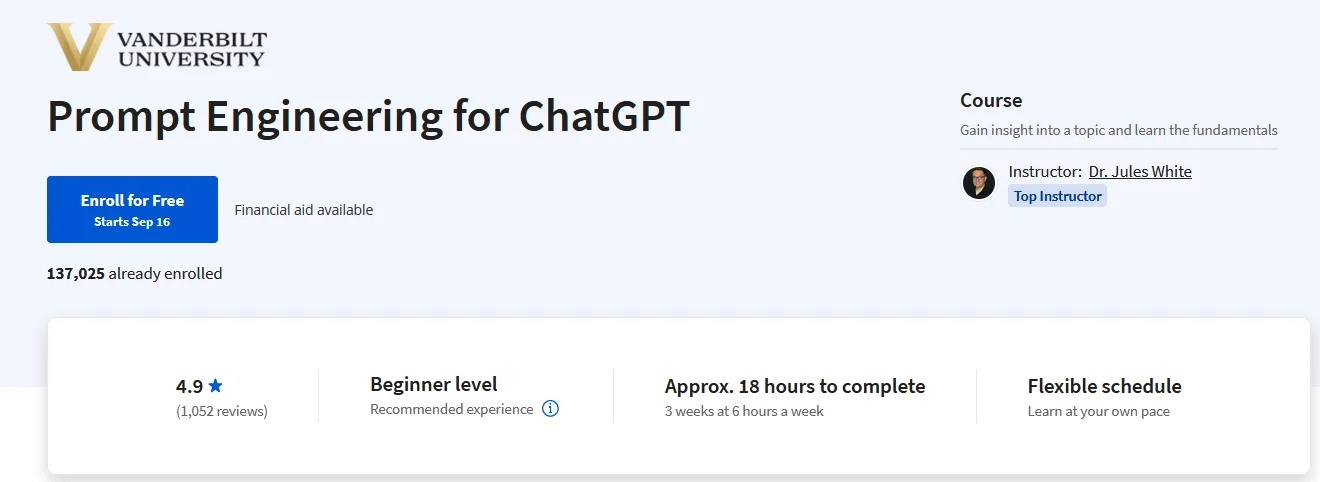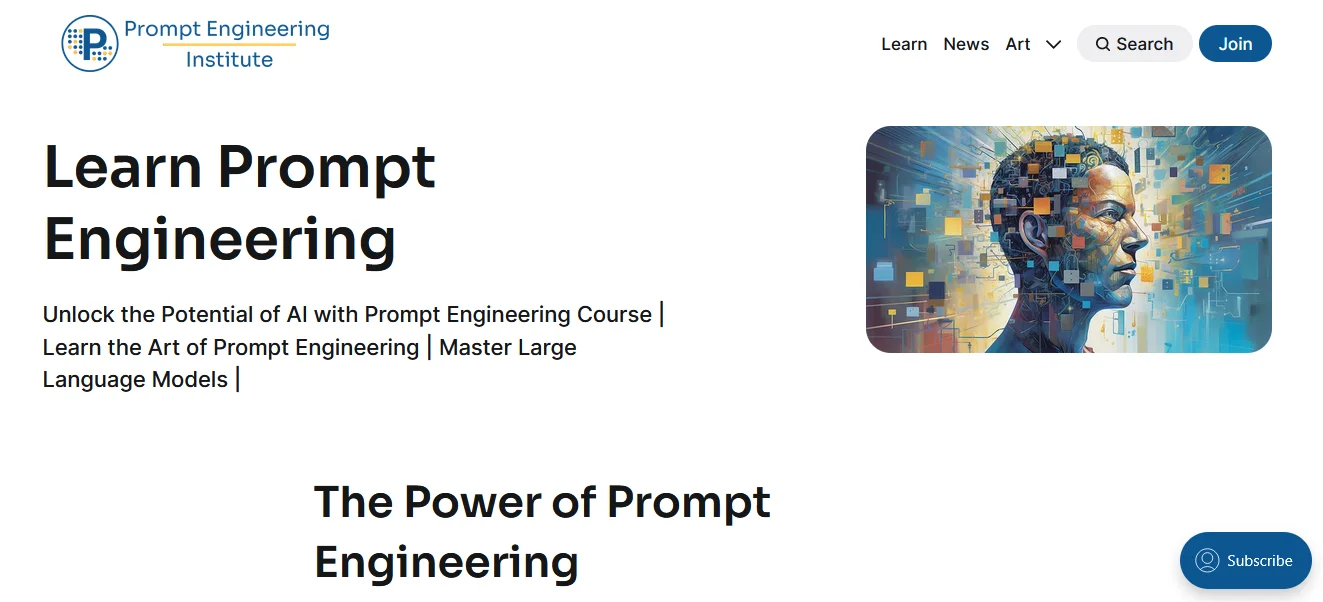Prompt engineering courses have lately seen a rise in popularity due to their significant impact on generative AI operations. The immense potential of ChatGPT and other large language models showcases how prompt engineering can improve our lives and work further than our smartphones if employed effectively.
What Is Prompt Engineering?
Prompt engineering is a technique for getting the desired output of large language models (LLMs). It involves carefully written input prompts so that the LLM can better understand the context and generate the desired outcome. It helps to produce more accurate and useful results from the language model.
Why Is Prompt Engineering Important?
One of the main reasons why prompt engineering is important is because most people struggle to create effective prompts for LLMs. Users can fully utilize these tools and use them for a wider variety of tasks by learning how to write better prompts. Additionally, well-designed prompts make it possible for the language model to operate more quickly while using fewer resources and time.
Prompt Engineering for ChatGPT by Coursera

Dr. Jules White, an Associate Professor of Computer Science at Vanderbilt University, is the creator of this course. You can audit the course for free.
This course will educate you on the art of prompt engineering, allowing you to work effectively with large language models like ChatGPT. You can tap into the immense capabilities of these models by understanding how to write good prompts and influence prompt patterns. Large language models have the eventuality to revise your life and business, whether it’s training your child in maths, creating individualized mess plans, or perfecting your cybersecurity.
You’ll gain practical knowledge and insights into using these generative AI tools throughout the course. You will become an expert user capable of solving complex problems and maximizing productivity in a variety of domains.
The course is intended for both newcomers and people with basic computer skills. Starting with simple prompts, you’ll produce sophisticated prompts for a variety of tasks.
By the end of the course, you’ll have developed strong prompt engineering capacities that will allow you to use huge language models in business, particularly life, and educational tasks such as writing, summarization, games, planning, simulation, and even programming.
ChatGPT Prompt Engineering for Developers by Deeplearning.ai

This course, presented by OpenAI experts Isa Fulford and Andrew Ng of DeepLearning.AI, will provide you with the information and skills you need to properly harness the power of Large Language Models (LLMs).
The training is intended for both beginners with a basic knowledge of Python and advanced machine-learning engineers. This training will provide essential insights and strategies whether you are new to prompt engineering or looking to improve your skills.
Generative AI offers many opportunities for AI engineers to build, in minutes or hours, powerful applications that previously would have taken days or weeks. I’m excited about sharing these best practices to enable many more people to take advantage of these revolutionary new capabilities.~ Andrew Ng
This course will provide you with the knowledge and skills needed to effectively use LLMs and build strong applications. You will discover how to overcome technical boundaries and create value in previously unthinkable ways by using the OpenAI API.
This course will give you the knowledge and skills demanded to effectively use LLMs and make strong applications. You’ll discover how to overcome specialized boundaries and produce value in unthinkable ways by using the OpenAI API.
The following important topics are covered throughout the course:
Key Topics Covered:
Understanding LLMs: You will learn about the inner workings of LLMs and their application development potential.
Best Practices for Prompt Engineering: Discover the ideas and approaches for creating prompts that evoke correct and meaningful responses.
Utilizing LLM APIs: Discover how LLM APIs can be applied in various tasks, including summarization (e.g., condensing user reviews), inference (e.g., sentiment classification, topic extraction), text transformation (e.g., translation, spelling and grammar correction), and expansion (e.g., automated email writing).
Hands-on Experience: Engage in practical exercises using Jupyter Notebook environments to experiment with prompt engineering and strengthen your skills.
Collaboration with OpenAI: This course is a joint effort between Coursera and OpenAI, ensuring that you learn the most up-to-date information and stylish practices for using LLMs. The expertise of OpenAI in the sector ensures that you’ll be at the forefront of rapid-fire engineering advancements.
Check Out Other Short Courses On LLMs By Deeplearning.ai
Learnprompting.org: Guide to Communicating with Artificial Intelligence

Learn Prompting’s Introductory Course on Generative AI and Prompt Engineering is a free and thorough tutorial for both non-technical and technical readers. It is an excellent beginning point for those who are new to Generative AI and Prompt Engineering.
This course has been cited by Wikipedia and is used by employees at O’Reilly, Scale AI, and OpenAI. You may also notice that this course is used in practically every other prompt engineering video and tutorial. They have a proud community to support prompt engineering, which includes our 1.3 million users and 40 thousand Discord members.
The course emphasizes practicality, focusing on research-backed solutions that you can immediately apply to your projects and applications. It gives simple examples that demonstrate how and when to apply various strategies.
Here is an overview of the modules:
- Basics: Fundamentals of prompt engineering and essential techniques
- Basic Applications: simple and practical applications.
- Intermediate: Research-based prompt engineering techniques with moderate complexity.
- Applied Prompting: Comprehensive process walkthroughs contributed by community members.
- Advanced Applications: Powerful and more complex applications of prompt engineering.
- Reliability: Enhancing the reliability of large language models (LLMs).
- Image Prompting: Prompt engineering for text-to-image models, such as DALLE and Stable Diffusion.
- Prompt Hacking: Exploring prompt engineering through hacking challenges.
- Tooling: Review of various prompt engineering tools and integrated development environments (IDEs).
- Prompt Tuning: Refining prompts using gradient-based techniques.
- Miscellaneous: Additional topics and techniques related to prompt engineering.
To assist learners in understanding the difficulty level and technical knowledge required, articles in the course are rated using a color-coded system:
🟢 Beginner-friendly; no programming required.
🟡 Easy; basic programming knowledge necessary, but no specialized expertise.
🔴 Intermediate; programming skills and some domain knowledge required.
🟣 Advanced; programming expertise and in-depth domain understanding are needed.
Check Out Our Essay Chatgpt Essay Writer Guide To Practice Prompting On Essay.
The Prompt Engineering Guide by DAIR.AI

DAIR.AI’s Prompt Engineering Guide is a project focused on educating researchers and practitioners about prompt engineering. The DAIR.AI’s overarching mission is to democratize AI research, education, and technologies, with a vision of empowering the next generation of AI innovators and creators.
In the development of this project, They have drawn inspiration from various open resources, including but not limited to OpenAI CookBook, Pretrain, Prompt, Predict, Learn Prompting, and numerous others.
The guide covers a wide range of topics related to prompt engineering:
Basic Concepts:
- LLM Settings
- Basics of Prompting
- Prompt Elements
- General Tips for Designing Prompts
- Examples of Prompts
Advanced Techniques:
- Zero-shot prompting
- Few-shot prompting
- Chain-of-thought prompting
- Self-consistency
- Generate knowledge prompting
- Tree of thoughts
- Retrieval augmented generation
- Automatic reasoning and tool use
- Automatic prompt engineering
- Directional stimulus prompting
- ReAct
- Multimodal CoT
- Graph prompting
The guide explores the practical operations of prompt engineering, including program-backed language models, generating data, generating law, and a graduate job classification case study. It also discusses different models such as Flan, ChatGPT, LLaMA, GPT- 4, and the LLM Collection. also, the guide addresses the risks and misuses associated with prompt engineering, including adversarial prompting, factuality, and biases.
The Master Prompt Engineering Course By Sunil Ramlochan:

The Master Prompt Engineering Course, instructed by Sunil Ramlochan, is a comprehensive and foundational course designed to provide a strong understanding of prompt engineering for Large Language Models (LLMs). The course covers various concepts, methodologies, and ways applicable to LLMs such as ChatGPT, Claude, GPT, and GPT-J.
The course is suitable for both professionals looking to enhance their productivity and skill set and individualities aspiring to become professional prompt masterminds. It offers a deep dive into prompt engineering and equips learners with chops that can be applied in both professional and personal contexts. The course gives a comprehensive understanding and hands-on experience in the subject for anyone interested in pursuing a career in prompt engineering.
The course objectives:
- Understanding prompt engineering basics and the role of prompt engineers in Generative AI-powered systems and Natural Language Processing (NLP).
- Increasing your understanding of Large Language Models (LLMs) and how they work.
- Developing, optimizing, and personalizing prompts for various AI models.
- Investigating a variety of prompting concepts and strategies, including zero-shot and few-shot prompting, Chain of Thought Prompting, Knowledge Generation Prompting, and others.
- Learning how to optimize LLMs for structured outputs and knowledge retrieval.
- Navigating frequent LLM challenges, such as hallucinations, and coming up with creative solutions.
- Understanding the Tree of Thought Prompting strategy for improving problem-solving in AI language models.
- Using AI prompts libraries efficiently for efficient organization, faster development, and improved collaboration.
The course content covers a wide range of topics, including an introduction to prompt engineering, the role of prompt engineers, the theory and importance of prompts in AI content creation, an introduction to Large Language Models, prompt optimization and customization, zero-shot and few-shot prompting, fine-tuning LLMs, Chain of Thought Prompting, Knowledge Generation Prompting, self-consistency prompting, prompt libraries for LLMs, reflexion as an iterative approach to LLM problem-solving, priming for enhancing context and conversation in LLMs, role-playing in LLMs, Navigating LLM Issues, and Tree of Thought Prompting.
The course is offered in two formats:
- Free, Self-Paced Written Lessons: Learners can have access to a set of essential written lessons that they can complete at their speed. This format is both flexible and inexpensive.
- Paid Video Course with Instructor Access: Students can choose the all-inclusive paid option, which includes dynamic and interactive video lessons. This format also offers extra hints, tips, and walkthroughs. Learners receive exclusive access to the teacher for personalized instruction and support as a premium advantage.
Conclusion:
As generative AI models continue to evolve, a new field area has arisen called prompt engineering, which is the skill of adding appropriate prompts to guarantee that the machine comprehends human language precisely as intended by the user. This has led to numerous courses, tools, and employment opportunities for prompt engineering skills.
3 Responses